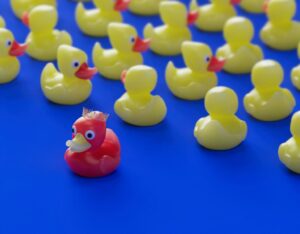Are you wondering what’s the plural of moose is? Well, you’re in luck because we’ve got all the answers right here. Whether it’s ‘moose’, ‘meese’, or ‘mooses’ that you want to know about, let us explain why each one has been used historically and why it matters for professionals and writers who are looking to be precise.
We’ll take a closer look at the history of these terms, both in English as well as other languages, so get ready—in no time we will have crept up on our answer!
What is the Plural of Moose?
The plural of moose might not be something you think about daily, but it’s a fascinating linguistic topic nonetheless. You might expect the plural to be “mooses,” but it’s actually “moose” for both the singular and the plural form. This may seem odd, but it’s not unheard of in English – think of “deer” and “sheep” as other animals with unchanged plural forms.
The word “moose” itself comes from an Algonquian language, likely meaning “twig-eater.” Interestingly, “moose” used to refer to European elk until the 18th century, when it was applied to the North American animal we know today. So, the next time you see multiple moose, remember that you can simply call them “moose” – no need to add an S!

How to Form a Plural Noun
Do you ever find yourself wondering what the plural of moose is? If so, you’re not alone. It’s a common question that comes up when discussing these majestic animals. Fortunately, forming the plural of moose is quite simple once you understand how English works.
Step 1: Understand the Basic Rules of English Plurals
The first step in forming a plural noun of moose is to understand the basic rules of English plurals. Generally, most words form their plurals by simply adding an -s or -es to the end. For example, if you want to make the word “dog” plural, you would add an -s and it would become “dogs.”
Step 2: Know When to Use an Apostrophe
In some cases, English requires the use of an apostrophe when forming a plural noun. For example, if you want to make the word “moose” plural, then you must add an apostrophe before the -s. This would make the plural of moose “moose’s.”
Step 3: Understand Irregular Forms
English also has a few irregular forms when it comes to plurals. For example, if you want to make the word “goose” plural, then you must add an -es instead of an -s. This would make the plural of goose “geese.”
Step 4: Know When to Use a Hyphen or Dash
In some cases, English requires the use of a hyphen or dash when forming a plural noun. For example, if you want to make the words “mother-in-law” plural, then you must add a dash before the -s. This would make the plural of mother-in-law “mothers-in-law.”
By following these steps, you can confidently form the plural of moose correctly and use it in any conversation or writing. So next time you need to write about these majestic animals, you can rest assured that you know exactly what to do.
The Three Options for the Plural of Moose
Did you know that the plural of moose can be quite confusing? In fact, there are three different options depending on the circumstance.
- If you’re talking about multiple moose in a general sense, you can simply use the word “moose” as the plural, similar to how “sheep” is both singular and plural.
- If you’re referring to multiple types of moose, such as Alaskan moose and Canadian moose, you would use “moose” as well, but add a word like “species” or “types” to clarify.
- If you’re referring to multiple moose in a specific location or group, you would use the word “meese,” which is a humorous and informal way to refer to the plural form.
Who knew one animal could have such diverse plural options?
Which is Correct – “Moose,” “Meese,” or “Mooses”?
If you’ve ever wondered what the plural form of “moose” is, you’re not alone. Many people mistakenly believe that “meese” is the correct term, but this is actually incorrect. The word “moose” is what is known as an “irregular” noun, meaning that it does not follow the standard rules of English pluralization.
Therefore, the plural form of “moose” is simply “moose.” While this may sound strange to some, it is in fact the correct form. So the next time you encounter a group of these majestic creatures, you can confidently refer to them as “moose.”
Conclusion
Moose are majestic animals that have a long history of being an integral part of North American cultures. They can be found in many different environments, and their unique features make them stand out from other wildlife species. Moose populations have been decreasing over the years due to hunting and habitat loss, so we need to take steps towards protecting these creatures if we want to ensure they remain on this planet for generations to come.
Understanding the plural of moose is relatively straightforward once you understand English grammar rules and when to use an apostrophe or a hyphen. The most common form for the plural of moose is simply “moose,” though there are other options depending on context. So next time you encounter multiple moose in your environment, make sure you know what to do! With these tips in mind, we hope that now you have a better understanding of how English plurals can be confusing – especially with majestic creatures like the moose!
FAQs
What is the plural of moose?
The plural of moose is simply “moose.” No apostrophe or hyphen is necessary.
Is there ever a time when an apostrophe should be used with the plural of moose?
Yes, if you are referring to possession involving multiple moose, then use an apostrophe. For example, “the moose’s antlers were impressive.”
Are there any other rules for using the plural of moose?
There are also times when you may need to use a hyphen when writing about multiple moose. This would apply if you were talking about two separate entities, such as “two little mooses”. In this case, it would be correct to write “two little moose-s”.
Learning the plural for of moose may seem confusing at first, but it’s actually quite simple once you understand the basics of English grammar. So make sure you know what to do next time you encounter multiple moose in your environment! With this knowledge, your encounters with these majestic creatures will be nothing short of impressive.




